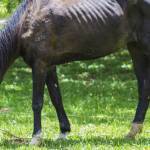Diets Evaluated for Refeeding Starved Horses

Some estimates put the number of unwanted horses as high as 100,000 per year, according to the Center for Equine Health at the University of California, Davis. Many of these unwanted horses end up neglected and underfed. Turned out in small pastures without sufficient forage, or even simply abandoned on public land where grass is scarce, they may lose hundreds of pounds of body weight.
Refeeding emaciated horses is a challenge because they have often lost all fat and carbohydrate stores and are staying alive by metabolizing protein, including heart and organ tissues. A too-rapid return to full feeding can trigger refeeding syndrome, a circumstance that leads to multiple system failures and death.
A study conducted at UC Davis compared three different rations for refeeding starved horses: alfalfa hay, oat hay, and a complete feed that combined grain, fat, alfalfa, and molasses. Each ration provided the same level of calories though the volumes were different. The diets were given to 22 starved horses during a ten-day period at the beginning of rehabilitation.
Horses eating the complete feed, a product high in carbohydrates, showed the expected response in which insulin was released in response to the starch component in the feed. Insulin not only facilitates carbohydrate uptake from the bloodstream, but also sends phosphorus and magnesium from the blood into tissue cells. In starved horses that have low levels of circulating electrolytes, this action leads within a week to failure of the kidneys, heart, and respiratory system.
Starved horses often responded to the bulky oat hay, which is high in fiber but low in protein, with diarrhea. This response led to a further depletion of fluid, nutrients, and electrolytes, making oat hay a poor dietary choice.
Alfalfa (lucerne) hay proved to be the best option for the early days of refeeding starved horses. Alfalfa contains a high level of protein as well as magnesium and phosphorus. It is relatively low in carbohydrates and therefore does not produce an excessive insulin response. High-quality alfalfa hay is leafy and fine-stemmed, qualities that make it easy to digest.
Even though alfalfa hay seems to be the best thing to feed a starved horse, giving the horse an unlimited supply is not recommended. Begin by feeding a large handful of hay every three hours around the clock, gradually increasing the amount and decreasing the number of feedings per day. This pattern should be followed for about two weeks, working toward being able to allow the horse to eat as much as it wants. The horse will slowly begin to gain weight, though it may take four to six months for a severely emaciated horse to return to good condition.








